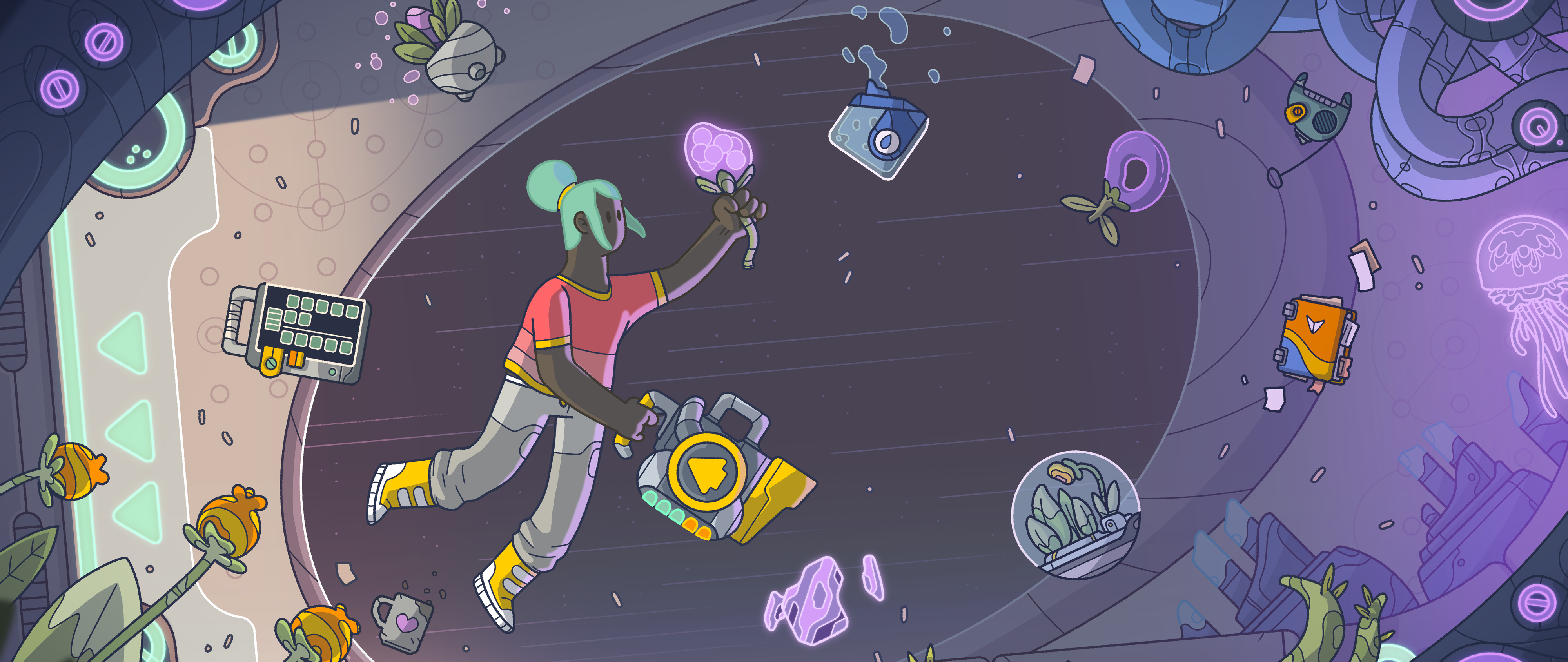
Space Sprouts Review
Memories can be elusive, but recalling them is a delightful little experiment in Space Sprouts.
Have you ever tried so hard to remember something, and just wish you could dive into your memories to tinker around until you connect all the dots? Space Sprouts, the new cozy solar punk time loop game from Schleuder Games, lets you do just that! Well, it lets you do it with someone else’s memory. You play as Oda, an inhabitant of a futuristic world filled with interplanetary travel and orbital space communities, as she recounts the tale of her first trip through space to a young relative. In her old age, Oda has forgotten some of the details of this trip, and you must help her put the pieces together by helping her explore the ship in a series of time loops.
As I explored the ship through Oda’s eyes, I immediately discovered all manner of items and tools scattered around. Many items have a primary use: some way that Oda can interact with them at a basic level. But I quickly found that the key to unlocking more memories was to find ways to use items in tandem with each other, or use them in some way to interact with the environment. This made for many quirky and surprising moments, like the time I accidentally set the bathroom on fire, or deactivated the gravity machine in the gymnasium. Some of these moments unlock specific memories that Oda has of her first outer space voyage. A select few of these are core memories, which unlock short cutscenes that reveal even more about Oda’s personality, life experiences, and reflections on that first trip.
Space Sprouts in Action
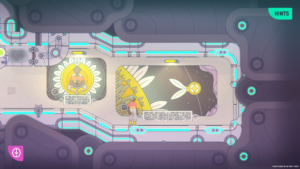
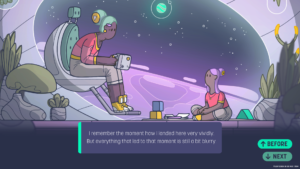


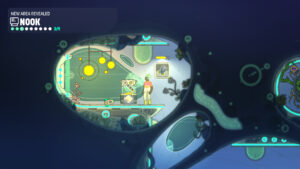


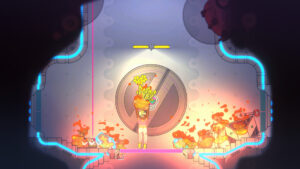
As with all time loop games, eventually your run comes to an end and you must restart from the beginning. I was a bit concerned at first, because you start with only about three minutes per loop, and even in that short time I could tell that the ship was pretty expansive. How on earth could I possibly make it to every nook and cranny of this ship in that time?
This is when I discovered a very clever aspect of Space Sprouts’ design. Every time you recall a memory, it adds a little bit more time to the duration of your next loop. So while three minutes felt like an impossibly short span in which to see everything, eventually I was able to explore, tinker and experiment for upwards of 14 minutes at a time. By the time I got to that point, I felt like I had ample time to try out new hypotheses and reach new corners of the ship.
A Non-Linear Time Loop
The ever-increasing length of each run is only one of the aspects I loved about Space Sprouts’ take on the time loop genre. Another is how well Schleuder Games crafted a non-linear experience in their game. Once you unlock a specific memory, there are very few times that you’ll be required to repeat it (with a few notable exceptions). I loved this, because I can get stressed out at times from the need to engineer the perfect sequence for a run in many other time loop games.
Although trying to optimize and order all of the steps of a single run in a linear time loop game can be fun, I find it can also get a little tedious, and frustrating if I get stuck or struggle to execute everything in the limited amount of time given. This game doesn’t do that to you, though. If you’re stumped by one mystery or blocked by an obstacle, there are always several other paths to explore. Many tools and solutions can be unlocked in any order or in multiple ways, so going down any open avenue feels like it could be a potential path to unlocking many other closed doors. Unlike in most time loop games I’ve played, my list of steps that I’d take at the start of every run was very short, and even those didn’t always feel essential to progressing.
Design Language, Speaking Volumes
I felt impressed most of the time by the game’s ability to wordlessly communicate what every gadget and piece of solar punk technology did and what its purpose was. There are no text prompts throughout the time loop portions of the game, other than when you successfully recall a memory. Instead, there are occasional diagrams on the walls and you’ll sometimes see thought bubbles appear over Oda’s head (which, to be honest, usually left me more confused). Yet, through experimentation, I was able to understand what most of these alien-looking objects did. Picking up and turning on the vacuum made it instantly understandable. Seeing silver canisters explode into a shower of water droplets on the floor immediately told me everything I needed to know about how I might use them.
I quickly found that the key to unlocking more memories was to find ways to use items in tandem with each other, or use them in some way to interact with the environment. This made for many quirky and surprising moments, like the time I accidentally set the bathroom on fire, or deactivated the gravity machine in the gymnasium.
This method of communicating the purpose and usage of objects through a consistent design language and encouraging player experimentation worked great for me… most of the time. There were moments where I happened upon a specific object interaction, or even pathway from one room to another, completely by accident and found it very difficult to reverse engineer what I had done.
By far the most charming and engaging moments of Space Sprouts were the surprise and delight experiences of interacting with the environment to produce wholly unexpected results. This is a game for tinkerers and the scientifically minded. Not to say that it’s complex or opaque, but rather that I had the most fun when I just focused on playing with each item I found, asking myself “what else might I use this for?” and pushing the boundaries of what seemed possible on this little ship. A couple of the rooms, like the botanical research lab or the chamber that houses the black hole, felt filled with possibility.
Space Sprouts Trailer
I was grateful for these little lightning strike moments of discovery because, to be honest, they were my greatest source of motivation while playing the game. I enjoyed the sweet moments between Oda and her (I’m assuming) grandchild at the beginning and end of each loop, where she prompts you to continue exploring and recalling more memories. But overall, the game felt a little lacking in a central, overarching mission.
The general goal of “remember more” felt a little too broad to me, and I would have loved having a specific recollection that I knew we were trying to get at in the end. I found the core memory cutscenes charming and I appreciated the window into Oda’s mind that they provided, but I kept trying to find a common thread to tie it all together. There was a hint of a thread, but I never got the sense that it was building to any specific culminating takeaway. That said, if you buy into the idea that “it’s not the destination, it’s the journey,” then I have to say this journey was cute, quirky, and filled with wonderful little surprises.
Get to the point, girl
Emily’s Score: 7.5/10
Emily was provided with a review key of Space Sprouts by Schleuder Games
About No Small Games
No Small Games is an indie game recap and review podcast brought to you by hosts Kate and Emily! They became friends while streaming on Twitch and bonded over their love of indie video games. In each episode of No Small Games, the two will discuss an indie game they both played independently. They’ll compare their experiences: the good, the bad, their most memorable moments of their playthroughs.
Learn more about the podcast and its hosts on the About page.


